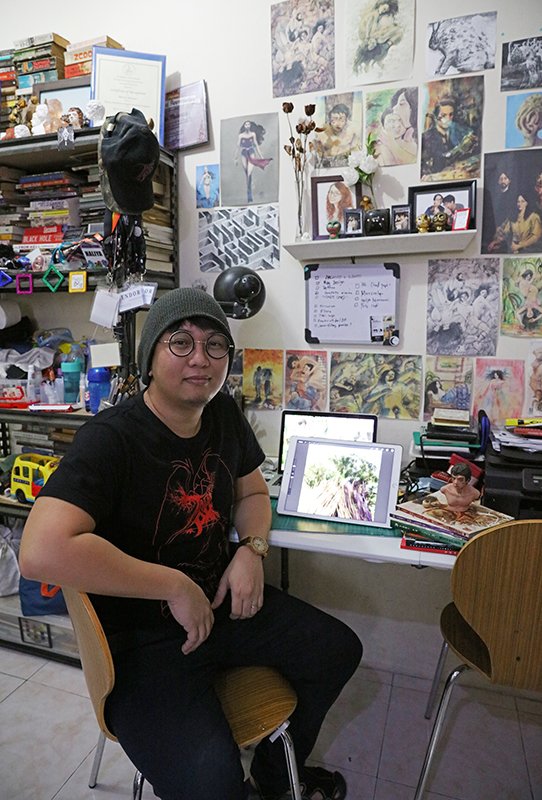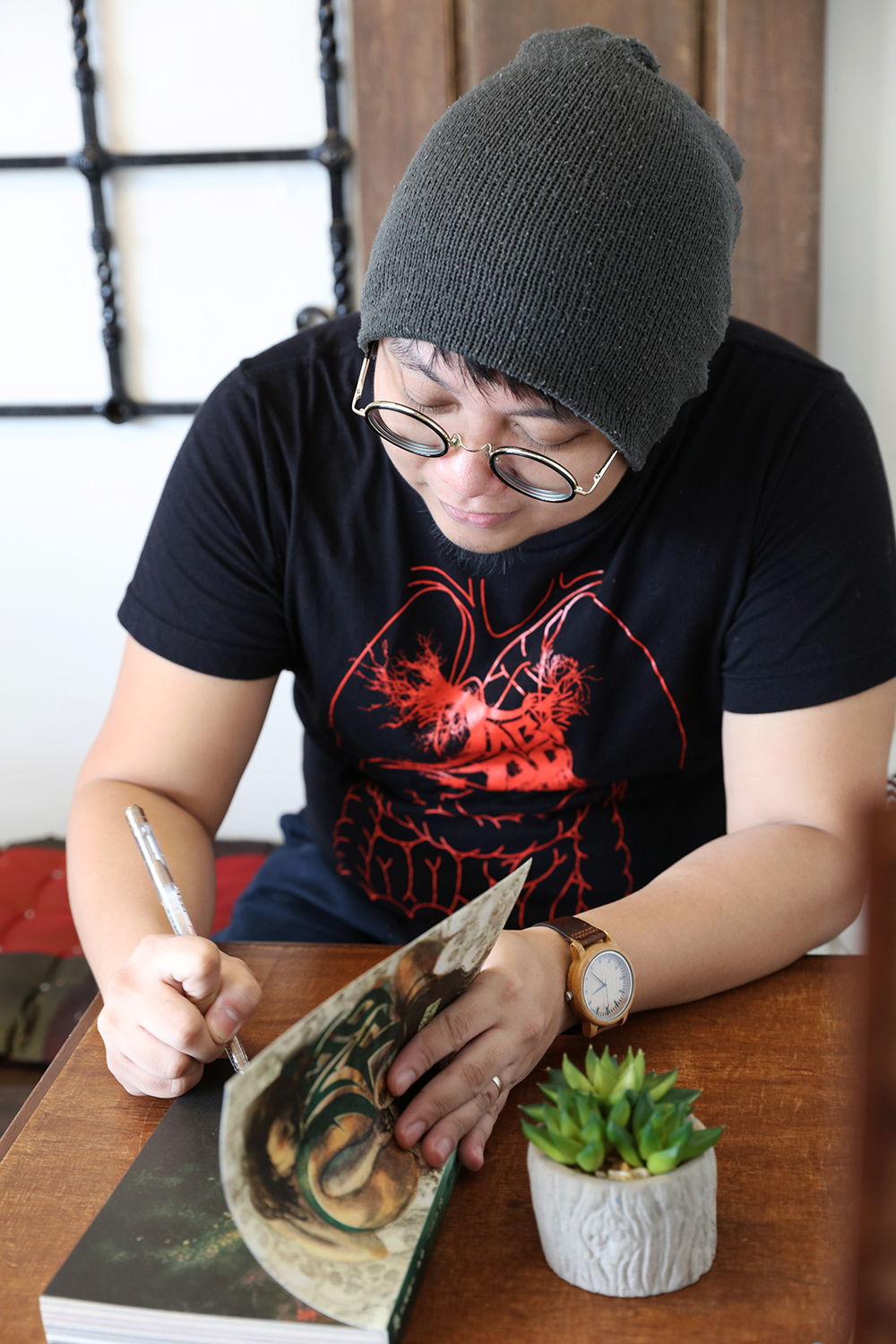by Arlyn VCD Palisoc Romualdo
Funny Komiks made Mervin Malonzo realize he could tell stories with drawings. His family had just moved into another rental house and the former occupants had left copies lying around. The future magna cum laude graduate and National Book Award winner was in the third grade then.
“I don’t remember a time I wasn’t drawing. And those comics made me decide I wanted to create comics, too.”
Slips and bumps
It hasn’t been easy. “We weren’t rich. My father repaired watches. My mother was a housewife.” He drew on his old notebooks, and an aunt who was a teacher gave him test papers she had finished checking, the blank sides of which he used. That same aunt, who Mervin had thought was encouraging him, also told him he couldn’t make a living out of his illustrations because he “could only succeed if he was good at it.”
Perhaps it was because he was an achiever in school who excelled in math and science that his aunt wanted him to go for a more lucrative career. But even if he was the eldest of five children, his parents never expected him to be the breadwinner. They just told him to “do what made him happy,” so he planned to take up Fine Arts in UP Diliman (UPD) to help him achieve his dream of making comics.

But Mervin didn’t make the cut. He fell short of the required UPD grade. He did qualify for his next choice: BS Chemistry at UP Los Baños.
There he was, disappointed, but ready to put his dream on hold. He had already found a dorm and was set on enrolling. Until he learned that the talent determination test in the Fine Arts program could still get him in.
In 2001, he entered UPD as a Painting major and all throughout, Mervin was a Pitoy Moreno scholar. It wasn’t hard for him to maintain the scholarship grade requirement. The genuine desire to learn that made him excel in his younger years persisted when he entered UP.
“I didn’t struggle too much with the studying part of UP life. Finances were harder to deal with.”
Love, horror, and making a living
He met Princess when she was a freshman at the Asian Institute of Tourism and he was a year from graduating. A friend had given him her number in hopes of setting them up because she was in UP, too; but it was months before he did something about it.
It was December 2013 and he had been living in a relative’s house without electricity for roughly a year. He was continuing to develop the story that had been brewing since he was 17—a story inspired by, but not quite similar to, the characters in Jose Rizal’s Noli Me Tangere and El Filibusterismo, mixed with Philippine mythology and horror, all of which interested him greatly.

“Living alone in a dark house can be scary but I fought that fear through the horror in my story. It was horror I controlled.” But loneliness was another matter, so he reached out to Princess.
To his surprise, they were actually classmates in Natural Sciences 2 and were practically neighbors! They only met in person when classes resumed, and as their relationship developed, so did his story.
After he graduated in 2005, he took on jobs as an in-house artist and designer for some companies. “I wanted to show people I could earn a living as a Painting graduate.” So despite his dream of creating comics, his story, Tabi Po, had to wait.
Breaking free
He learned how to use digital art tools for work and it didn’t take long for him to translate traditional painting practices into the new medium. In 2010, he uploaded Tabi Po online, making it freely available for anyone to read. It gained popularity and for a while, Mervin was content with simply sharing his work with the world.
An incident at his workplace years later forced him to reassess his career. He was the creative head of new media who was suddenly denied entry because of the leather sandals he usually wore. It then occurred to him that success in that track meant doing things that didn’t fit his personality; so he quit shortly after.

He became a freelance artist who did illustration and web design jobs. He had more time to devote to Tabi Po and the clamor for a print version was increasing. In just a year, Tabi Po Isyu 1 was published and won the 2014 National Book Award for Graphic Literature. He reveals it was one of his proudest moments.
“I was recognized not only as an artist but also as an author. I got an award for realizing my dream of telling a story through comics. It was better than all my academic honors combined.” He still feels bad though, that dengue prevented him from going to the awards ceremony.
What followed was an offer to turn it into a live action TV series. From the time he won until Tabi Po was aired in 2017, Isyu 2 was printed, Isyu 3 was being completed, he and Princess had gotten married, and baby El was born. He had also decided, at the end of 2016, that he would just focus on comics—as a creator, illustrator, and publisher. With the full support of Princess and together with friends Aliyah Luna and Adam David, Haliya Publishing was born. One of its first releases was Tabi Po Isyu 3.
A balancing act
As co-founder and co-owner of Haliya, Mervin continues to learn the ropes of publishing, including production, marketing, and sales, among others. Even with added work, he and Princess continue to be hands-on parents to El. He admits with a laugh that the one-year-old is, in fact, “the boss.” When they both need to work, El is looked after by Mervin’s parents and siblings who live with them.

The balancing act hasn’t hampered his creativity. He is continuing the Tabi Po series with another story arc. Mervin the artist and storyteller is also no longer content with letting people merely read his stories and enjoy his illustrations. He has created sculptures of his Tabi Po characters. He is animating not just his work but also others published by Haliya. Based on the online reception, people can’t get enough of his creations.
“I want more people to appreciate the stories of Filipino writers, through comics or graphic novels, through animation. I want to show everyone that Filipinos can do these things and do these well.”
Source: https://www.up.edu.ph/index.php/the-artist-as-storyteller/
